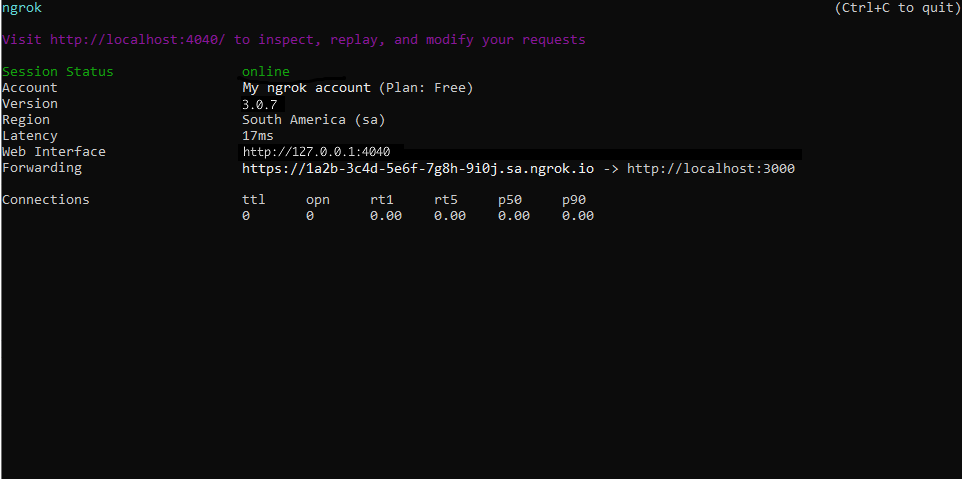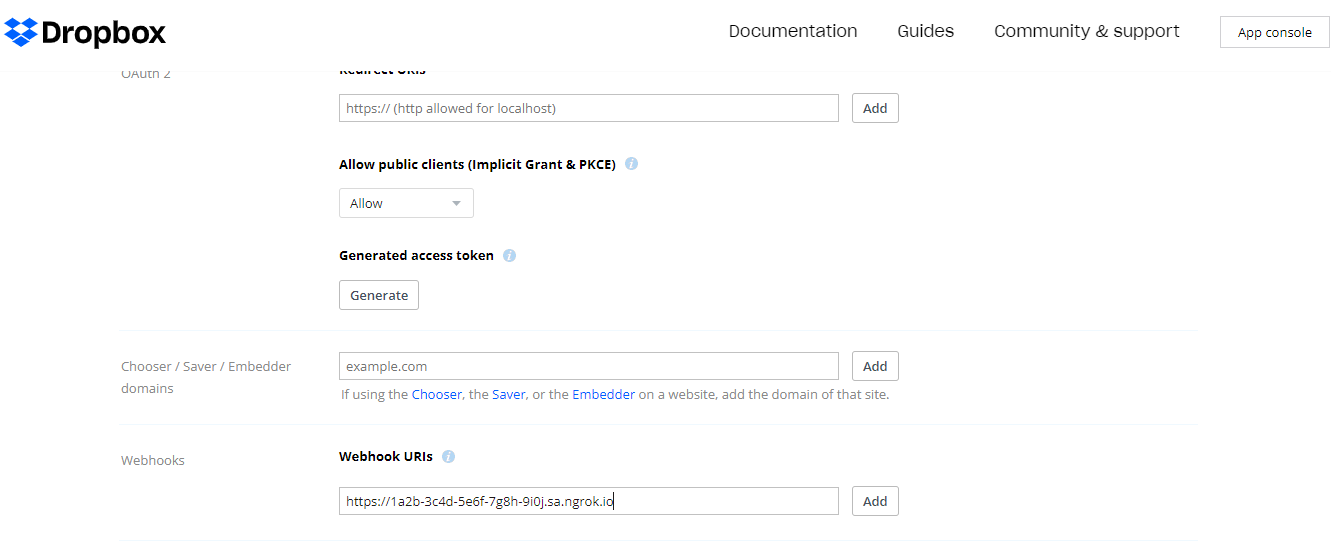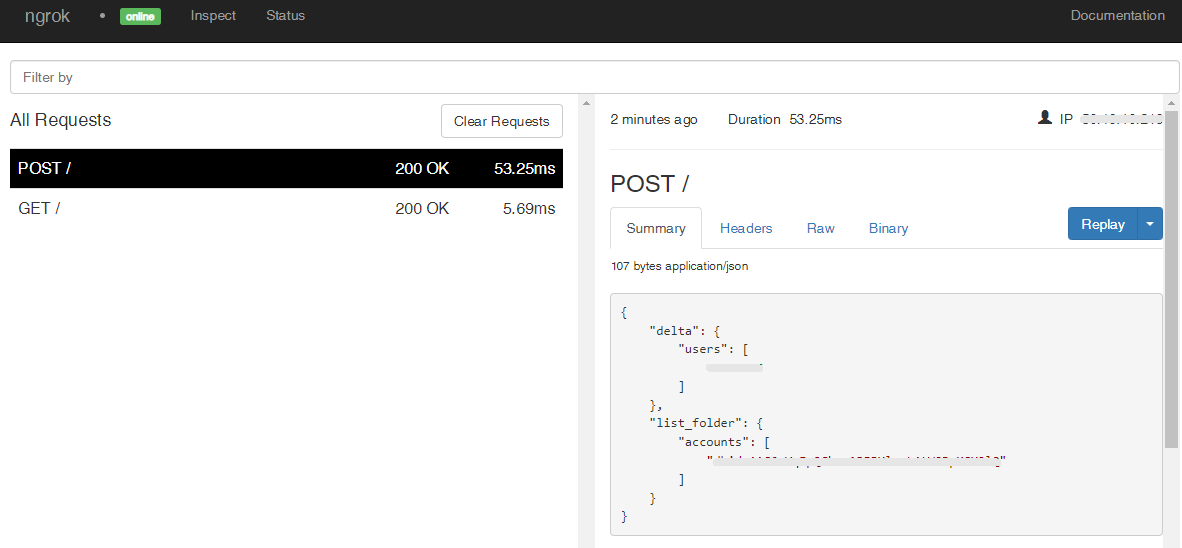Dropbox Webhooks
To integrate Dropbox webhooks with ngrok:
This guide covers how to use ngrok to integrate your localhost app with Dropbox by using Webhooks. Dropbox webhooks can be used to notify an external application whenever specific events occur in your Dropbox account.
By integrating ngrok with Dropbox, you can:
- Develop and test Dropbox webhooks locally, eliminating the time in deploying your development code to a public environment and setting it up in HTTPS.
- Inspect and troubleshoot requests from Dropbox in real-time via the inspection UI and API.
- Modify and Replay Dropbox Webhook requests with a single click and without spending time reproducing events manually in your Dropbox account.
- Secure your app with Dropbox validation provided by ngrok. Invalid requests are blocked by ngrok before reaching your app.
Step 1: Start your app
For this tutorial, we'll use the sample NodeJS app available on GitHub.
To install this sample, run the following commands in a terminal:
Loading…
This will get the project installed locally.
Now you can launch the app by running the following command:
Loading…
The app runs by default on port 3000.
You can validate that the app is up and running by visiting http://localhost:3000. The application logs request headers and body in the terminal and responds with a message in the browser.
Step 2: Launch ngrok
Once your app is running successfully on localhost, let's get it on the internet securely using ngrok!
-
If you're not an ngrok user yet, just sign up for ngrok for free.
-
Go to the ngrok dashboard and copy your Authtoken.
Tip: The ngrok agent uses the auth token to log into your account when you start a tunnel. -
Start ngrok by running the following command:
Loading…
-
ngrok will display a URL where your localhost application is exposed to the internet (copy this URL for use with Dropbox).

Step 3: Integrate Dropbox
To register a webhook on your Dropbox account follow the instructions below:
-
Access the Dropbox site, sign in using your Dropbox account, and then access the Dropbox developer site.
-
On the My apps page, click Create app.
-
On the Create a new app page, click Scoped access, click App folder under the Choose the type of access you need section, enter a name for your app in the App name field, click the terms and condition checkbox, and then click Create app.
-
On your app page, enter the URL provided by the ngrok agent to expose your application to the internet in the Webhook URIs field (i.e.
https://1a2b-3c4d-5e6f-7g8h-9i0j.ngrok.app) and click Add in the Webhooks section.
Confirm your localhost app receives a one-time call from Dropbox and logs the query challenge parameter in the terminal.
-
Confirm your webhook appears in the Webhooks section of the app page with the Enabled status.
Run Webhooks with Dropbox and ngrok
Because you registered your app with the App folder type of access, Dropbox creates a new folder with the name of your app under the Apps folder.
Tip: You can create a new app with Scoped access as Full Dropbox which will trigger notifications on any folder on your dropbox account.
Every time you upload a file to the app folder or modify a file inside this folder, Dropbox sends a notification to your application whenever you upload files to a folder. To upload a file follow the steps below:
-
Access the Dropbox site, sign in using your Dropbox account, and click Apps under the All files section on the left menu.
-
The name of your app appears as a folder in the list, click this folder and then upload a file from your desktop by dragging and dropping it into the folder area of the browser.
After the file upload process is completed, Dropbox sends a post request to your application.
Note: The payload of this post request doesn't include any actual file/folder changes. It only informs your app of which users have changes. To gather information about the file uploaded your app will need to call Dropbox API to get the latest changes for each user in the notification.
Inspecting requests
When you launch the ngrok agent on your local machine, you can see two links:
- The URL to your app (it ends with
ngrok-free.appfor free accounts orngrok.appfor paid accounts when not using custom domains) - A local URL for the Web Interface (a.k.a Request Inspector).
The Request Inspector shows all the requests made through your ngrok tunnel to your localhost app. When you click on a request, you can see details of both the request and the response.
Seeing requests is an excellent way of validating the data sent to and retrieved by your app via the ngrok tunnel. That alone can save you some time dissecting and logging HTTP request and response headers, methods, bodies, and response codes within your app just to confirm you are getting what you expect.
To inspect Dropbox's webhooks call, launch the ngrok web interface (i.e. http://127.0.0.1:4040) and then click one of the requests sent by Dropbox.
From the results, review the response body, header, and other details:

Replaying requests
The ngrok Request Inspector provides a replay function that you can use to test your code without the need to trigger new events from Dropbox. To replay a request:
-
In the ngrok inspection interface (i.e.
http://localhost:4040), select a request from Dropbox. -
Click Replay to execute the same request to your application or select Replay with modifications to modify the content of the original request before sending the request.
-
If you choose to Replay with modifications, you can modify any content from the original request. For example, you can modify the users field inside the body of the request.
-
Click Replay.
Verify that your local application receives the request and logs the corresponding information to the terminal.
Secure webhook requests
The ngrok signature webhook verification feature allows ngrok to assert that requests from your Dropbox webhook are the only traffic allowed to make calls to your localhost app.
Note: This ngrok feature is limited to 500 validations per month on free ngrok accounts. For unlimited, upgrade to Pro or Enterprise.
This is a quick step to add extra protection to your application.
-
Access the Dropbox developer site, click the name of the app you created in the Integrate Dropbox step, click Show for the App secret field of the Settings tab, and then copy the value that appears on the page.
-
Restart your ngrok agent by running the command, replacing
{your app secret}with the value you have copied before:Loading…
-
Access the Dropbox site, sign in using your Dropbox account, and then upload a new file to the app folder.
Verify that your local application receives the post request and logs information to the terminal.